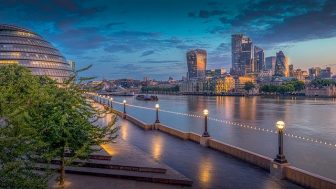 Rents across all prime London regions saw a return to positive growth in the second quarter of the year, as both UK and international tenants planned their return to the capital, fresh analysis from Savills shows.
Rents across all prime London regions saw a return to positive growth in the second quarter of the year, as both UK and international tenants planned their return to the capital, fresh analysis from Savills shows.
This is the first time rents have increase in prime London since the start of the pandemic.
Strong rental growth continued across London’s commuter belt where demand from relocating families for three and four bedroom homes in regional towns and cities massively exceeded supply as ‘accidental tenants’ compete with try before you buy renters.
In the country markets, the study shows that connectivity has unsurprisingly become more important for those moving out of London while some wealthy tenants are opting to take a country house style residence in the London suburbs.
Average prime London rental values increased by 1% over the second quarter, with rents rising for both flats (+0.4%) and houses (+1.8%) as people continue to move back into London for work, study and leisure.
Two-thirds of Savills agents reported that corporate relocation demand had increased over the past three months, while a similar number reported falling stock levels as some landlords exited the sector and accidental landlords opted to sell into an improving sales market. Consequently, new demand is now exceeding supply particularly in the family house market.
Large properties with outside space continue to outperform, the search for space a clear legacy of repeated lockdowns. Rents for houses with five bedrooms or more increased 1.9% in the second quarter to bring annual growth to 2.6%, and for homes with a large garden rents were up 2% and +3.6% respectively.

The rental value of flats has also begun to recover, recording a marginal +0.4% increase in the second quarter, the first rise since March 2020, albeit values remain down -5.8% year on year, with prime south west London the only region where flat values remained stable across the year.
“Since the start of the year we’ve seen people begin to return to London and stock levels have slowly been coming down from their very high levels at the start of lockdown,” said Jessica Tomlinson, Savills research analyst. “But this is the first clear signal that prime rental values have resumed their steady upwards trend from the 2016 low that was curtailed by the March 2020 market shutdown.
“Last year tenants expected – and many got – a ‘lockdown deal’, but these are no longer a feature of the market. We’re also seeing the rental value of flats beginning to recover, while properties with terraces, balconies or even no outside space have returned to marginal rental growth. This suggests tenants may now be viewing larger outside space as a bonus rather than a deal breaker for the first time since March of last year.”
Meanwhile in the commuter zone, rental values ticked up by 2.5% with urban areas seeing the strongest growth.
“Across the commuter belt, we’ve also begun to see a change in priorities with people seeking to be closer to transport links and lifestyle amenities in town and city centres, in contrast to the flight to country properties in village and rural locations seen throughout last year,” said Tomlinson. “This means that annual rental growth in prime regional cities – at around +6.5% – is on a par with that seen in prime country locations.”
Suburban locations and those within London’s inner commuter zone such as Cobham, Tunbridge Wells, Sunningdale and Sevenoaks all experienced annual rises in excess of +11%, reflecting a desire among renters for good transport links as people begin their return to London workplaces.
Three and four bedroom houses in these inner commute family markets performed particularly strongly, experiencing growth of 10.7% and 10.1% on an annual basis with supply unable to keep pace with demand.
“Our agents across the commuter markets all reported competitive bidding taking place, with landlords often favouring those looking for longer term tenancies. This is causing issues for ‘accidental tenants’ – most notably young families moving out from London for schools and additional space – who’ve struggled to find the right home to buy or who had been planning a ‘try before you buy’ approach to a new area.”
 In the short term, Savills expects the strongest rental demand to continue to be for properties in the commuter belt and larger family homes in London. But the pattern of rental growth will continue to evolve in response to further relaxation of social distancing, the firm says.
In the short term, Savills expects the strongest rental demand to continue to be for properties in the commuter belt and larger family homes in London. But the pattern of rental growth will continue to evolve in response to further relaxation of social distancing, the firm says.
With evidence that London rents have bottomed out and corporate relocation searches are returning to ‘pre-pandemic’ levels, we expect to see a more sustained return to rental growth in the capital into the second half of this year and through 2022, at the same time tempering demand in the commuter belt towards the end of this year. This suggests that 2021 will be seen as the year of standout rental growth for prime properties beyond London.
As prime London rents continue to bottom out, Savills has restated its forecasts, published May 2021. The firm projects average five-year rental growth of 14.2% across the prime London markets and 13.1% across the prime commuter belt.


A good article from Savills. Rents in London were always going to bottom out in the weeks before office workers started to flood back into their City Offices and the bounce back has now started.
You must be logged in to like or dislike this comments.
Click to login
Don't have an account? Click here to register
Strong demand returning across sw London for rental properties, outside space is highly sought after at the moment.
While some people have moved to the country, there seems to be some signs that the commute is not what people thought it was, hence a small but steady demand for pied-a-terre properties around here.
‘Everyone’ moving to the country was a great headline, but the reality is somewhat different in our experience.
You must be logged in to like or dislike this comments.
Click to login
Don't have an account? Click here to register